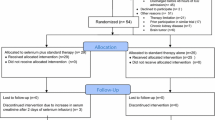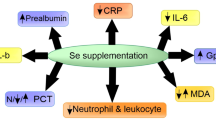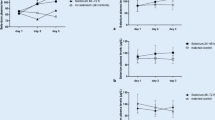Summary
A prospective observational study of parenteral selenium supplementation started in January 2008 which included 72 septic patients with APACHE II scores ranging from 19 to 40 after admission.
Patients were divided into two major groups: one with a continual infusion of sodium selenite at 750 µg/24 h for 6 days and a placebo group followed by subgroups according to the presence or absence of surgical procedure. Routine biochemical and hematological para-meters were determined continuously. Sequential Organ Failure Assessment (SOFA) scores were calculated in two-day intervals.
Patients who died had a higher Acute Physiology and Chronic Health Evaluation (APACHE) II score, lower albumin on the 3rd days of therapy and higher C-reactive protein (CRP) on the 6th days of therapy. Statistically, there was no significant difference in the comparison of CRP, fibrinogen, albumin, plasma proteins, or neutrophil to lymphocyte counts during the 6 days in all subgroups. There was a significant difference in the comparison of leukocytes on the 6th day of therapy. Glutathione peroxidase and glutathione reductase activity was increased in selenium subgroups with negative correlation in placebo subgroups during the therapy. A downward trend in SOD activity, more appreciable in selenium groups, seemed to be a reflection of lower superoxide radical production. This is biased more as a result of GPx activity restoration, preventing further peroxidation of organic substrates and cyclic formation of other radicals, than actual attenuation of their production.
Selenium substitution increased selenium dependent antioxidant enzyme activity and, in comparing mortality in groups, we found a 16.7 % decrease in mortality in favor of supplementation with selenium.
Zusammenfassung
Eine prospektive Beobachtungsstudie der Wirkung einer parenteralen Gabe von Selen wurde im Jänner 2008 begonnen. Es wurden 72 Patienten mit Sepsis und einem APACHE II Score zwischen 19 und 40 bei Aufnahme in die Studie aufgenommen.
Die Patienten wurden in 2 große Gruppen eingeteilt: einer Gruppe wurde eine kontinuierliche Infusion von 750 mg Na-Selenit/24 h 6 Tage lang verabreicht – der anderen Placebo. Es wurden dann Subgruppen gebildet, je nachdem, ob operative Maßnahmen gesetzt wurden. Routine biochemische und hämatologische Parameter wurden kontinuierlich erhoben. Die SOFA Scores wurden alle 2 Tagen errechnet.
Die verstorbenen Patienten hatten einen höheren APACHE II Score, sowie ein niedrigeres Albumin am 3. Tag und ein höheres CRP am 6. Tag. Statistisch bestand kein signifikanter Unterschied im Vergleich des CRP, des Fibrinogens, des Albumins, der Plasmaproteine bzw. der Neutrophilen und Lymphozyten Zahl aller Subgruppen während der 6 Beobachtungstage. Die Leukozytenzahl war am 6. Tag statistisch signifikant unterschiedlich. Die Aktivität der Glutathionperoxidase (GPx) und der Glutathionreduktase war in den Selen-Subgruppen während der Therapie erhöht mit einer negativen Korrelation in den Placebo-Untergruppen.
Ein Abwärtstrend der SOD Aktivität, der in den Selen-Untergruppen deutlicher war, schien eine Folge einer geringeren Produktion von Superoxyd Radikalen zu sein. Wahrscheinlich ist das aber eher auf eine Wiederherstellung der GPx Aktivität (die vor einer weiteren Peroxydation der organischen Substrate und einer zyklischen Bildung von anderen Radikalen schützt) als auf eine tatsächliche Verminderung ihrer Produktion zurückzuführen.
Substitution mit Selen erhöhte die Aktivität der Selen-abhängigen antioxidativen Enzyme. Ein Vergleich der Mortalität beider Gruppen ergab eine um 16,7 % niedrigere Sterberate der mit Selen behandelten Patienten.

Similar content being viewed by others
Change history
04 April 2023
A Correction to this paper has been published: https://doi.org/10.1007/s00508-023-02191-7
References
Andrews PJ, Avenell A, Noble DW, Campbell MK, Croal BL, Simpson WG, Vale LD, Battison CG, Jenkinson DJ, Cook JA, Scottish Intensive care Glutamine or seleNium Evaluative Trial Trials Group. Randomized trial of glutamine, selenium, or both, to supplement parenteral nutrition for critically ill patients. BMJ. 2011; 342:d1542, doi:10.1136/bmj.d1542.
Angstwurm MW, Engelmann L, Zimmermann T, Lehmann C, Spes CH, Abel P, Strauss R, meier-Hellmann A, Insel R, Radke J, Schüttler J, Gärtner R. Selenium in Intensive Care (SIC): results of a prospective, randomized, placebo-controlled, multiple-center study in patients with severe systemic inflammatory response syndrome, sepsis, and septic shock. Crit Care Med. 2007;35(1):118–26.
Bela P, Bahl R, Sane AS, Sawant PH, Shah VR, Mishra VV, Trivedi HL. Oxidative stress status: possible guideline for clinical management of critically ill patients. Panminerva Med. 2001;43(1):27–31.
Bhat MA, Bhat JI, Kawoosa MS, Ahmad SM, Ali SW. Organism-specific platelet response and factors affecting survival in thrombocytopenic very low birth weight babies with sepsis. J Perinatol. 2009;29(10):702–8.
Blakytny R, Harding JJ. Glycation (non-enzymic glycosylation) inactivates glutathione reductase. Biochem J. 1992;288(Pt 1):303–7.
Briz O, Romero MR, Martinez-Becerra P, Macias RI, Perez MJ, Jimenez F, San Martin FG, Marin JJ. OATP8/1B3-mediated cotransport of bile acids and glutathione: an export pathway for organic anions from hepatocytes? J Biol Chem. 2006;281(41):30326–35.
Chan WS, Dedon CP. The biological and metabolic fates of endogenous DNA damage products. J Nucleic Acids. 2010;13, Article ID 929047, doi:10.4061/2010/929047.
de Menezes CC, Dorneles AG, Sperotto RL, Duarte MM, Schetinger MR, Loro VL. Oxidative stress in cerebrospinal fluid of patients with aseptic and bacterial meningitis. Neurochem Res. 2009;34(7):1255–60.
Faviere W, Boechat T. Sepsis: thrombocytopenia is bad, not recovering thrombocytopenia is too bad. Crit Care. 2011;15(Supp 1):P440.
Finley JW, Duffield A, Ha P, Vanderpool RA, Thomson CD. Selenium supplementation affects the retention of stable isotopes of selenium in human subjects consuming diets low in selenium. Br J Nutr. 1999;82(5):357–60.
Firment J, Hudak V, Grendel T. Difficulties in implementation of the recommendations for the diagnosis and treatment of severe sepsis and sepsis shock. Anesteziologie a Intenzivní Medicína 2008;19(5):252–9.
Forceville X, Laviolle B, Annane D, Vitoux D, Bleichner G, Korach JM, Cantais E, Georges H, Soubirou JL, Combes A, Bellissant E. Effects of high doses of selenium, as sodium selenite, in septic shock: a placebo-controlled, randomized, double-blind, phase II study. Crit Care. 2007;11(4):R73.
Geoghegan M, McAuley D, Eaton S, Powell-Tuck J. Selenium in critical illness. Curr Opin Crit Care. 2006;12(2):136–41.
Hardy G, Hardy I. Selenium: the Se-XY nutraceutical. Nutrition. 2004;20(6):590–3.
Heyland D. Selenium supplementation in critically ill patients: can too much of a good thing be a bad thing? Crit Care. 2007;11(4):153.
Ince C. The microcirculation is the motor of sepsis. Crit Care. 2005;9(Supp 4):13–9.
Kharb S, Singh V, Ghalaut PS, Sharma A, Singh GP. Role of oxygen free radicals in shock. J Assoc Physicians India. 2000;48(10):956–7.
Kuklinski B, Zimmermann T, Schweder R. Decreasing mortality in acute pancreatitis with sodium selenite. Clinical results of 4 years antioxidant therapy. Med Klin (Munich). 1995;90 (Supp 1):36–41.
Levy MM, Fink MP, Marshall JC, Abraham E, Angus D, Cook D, Cohen J, Opal SM, Vincent JL, Ramsay G. 2001 SCCM/ESICM/ACCP/ATS/SIS International Sepsis Definitions Conference. Intensive Care Med. 2003;29:530–8.
Mahagita C, Grassl SM, Piyachaturawat P, and Ballatori N. Human organic anion transporter 1B1 and 1B3 function as bidirectional carriers and do not mediate GSH-bile acid cotransport. Am J Physiol Gastrointest Liver Physiol 2007;293(1):G271–8.
Manzanares W, Biestro A, Torre MH, Galusso F, Facchin G, Hardy G. High-dose selenium reduces ventilator-associated pneumonia and illness severity in critically ill patients with systemic inflammation. Intensive Care Med. 2011;37(7):1120–7.
Manzanares W, Hardy G. The role of prebiotics and synbiotics in critically ill patients. Curr Opin Clin Nutr Metab Care. 2008;11(6):782–9.
Meisner M. Biomarkers of sepsis: clinically useful? Curr Opin Crit Care. 2005;11(5):473–80.
Menges T, Engel J, Weters I, Wagner RM, Little S, Ruwoldt R, Wollbrueck M, Hempelmann G. Changes in blood lymphocyte populations after multiple trauma: association with posttraumatic complications. Crit Care Med. 1999;27(4):733–40.
Mishra V, Baines M, Perry SE, McLaughlin PJ, Carson J, Wenstone R, Shenkin A. Effect of selenium supplementation on biochemical markers and outcome in critically ill patients. Clin Nutr. 2007;26(1):41–50.
Rayman MP. The importance of selenium to human health. Lancet, 2000;356(9225):233–41.
Ritter C, Andrades M, Frota Júnior ML, Bonatto F, Pinho RA, Polydoro M, Klamt F, Pinheiro CT, Menna-Barreto SS, Moreira JC, Dal-Pizzol F. Oxidative parameters and mortality in sepsis induced by cecal ligation and perforation. Intensive Care Med. 2003;29(10):1782–9
Salama A, Sakr Y, Reinhart K. The role of selenium in critical illness: Basic science and clinical implications. Indian J Crit Care Med. 2007;11(3):127–38.
Valenta J, Brodska H, Drabek T, Hendl J, Kazda A. High-dose selenium substitution in sepsis: a prospective randomized clinical trial. Intensive Care Med. 2011;37(5):808–15.
Wollin MS, Ahmad M, Gao Q, Gupte SA. Cytosolic NAD(P)H regulation of redox signaling and vascular oxygen sensing. Antioxid Redox Signal. 2007;9(6):671–8.
Záhorec R. Ratio of neutrophil to lymphocyte counts-rapid and simple parameter of systemic inflammation and stress in critically ill. Bratisl Lek Listy. 2001;102(1):5–14.
Zuurbier CJ, Eerbeek O, Goedhart PT, Struys EA, Verhoeven NM, Jakobs C, Ince C. Inhibition of the pentose phosphate pathway decreases ischemia-reperfusion-induced creatine kinase release in the heart. Cardiovascular Res. 2004;62:145–53.
Conflict of interest
None of the authors has any financial/commercial conflicts of interest with the published data.
Author information
Authors and Affiliations
Corresponding author
Rights and permissions
About this article
Cite this article
Janka, V., Ladislav, K., Jozef, F. et al. Restoration of antioxidant enzymes in the therapeutic use of selenium in septic patients . Wien Klin Wochenschr 125, 316–325 (2013). https://doi.org/10.1007/s00508-013-0371-x
Received:
Accepted:
Published:
Issue Date:
DOI: https://doi.org/10.1007/s00508-013-0371-x




